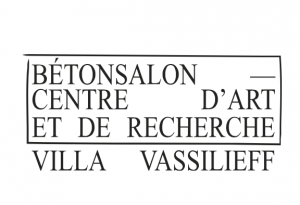A Day with Marie Vassilieff
At Fondation des Artistes – Nogent-sur-Marne (MABA, Maison Nationale des Artistes, Bibliothèque Smith-Lesouëf)
Mercedes Azpilicueta, Carlotta Bailly-Borg, Yto Barrada, Michel François, Christian Hidaka, Laura Lamiel, Mohamed Larbi Rahhali, Anne Le Troter, Flora Moscovici, Émilie Notéris, Thu-Van Tran, Marie Vassilieff
curated by Mélanie Bouteloup & Émilie Bouvard
May 16 – July 21, 2019
« Il nous faut, dans un monde où nous existons que passées sous silence, au propre dans la réalité sociale, au figuré dans les livres, il nous faut donc, que cela nous plaise ou non, nous constituer nous-mêmes, sortir comme de nulle part, être nos propres légendes dans notre vie même, nous faire nous-mêmes êtres de chair aussi abstraites que des caractères de livres ou des images peintes. »
Monique Wittig, « Avant –note » dans Djuna Barnes, La Passion, Paris, Flammarion, 1982, p.16
The Fondation Nationale des Arts Graphiques et Plastiques (FNAGP) in Nogent-sur-Marne and the Villa Vassilieff in Paris pay tribute to the figure of Marie Vassilieff who lived in their walls at different times of her life, through the exhibition A Day with Marie Vassilieff which unfolds in all their exhibition spaces: Maison Nationale des Artistes (MNA, retirement home of Nogent-sur-Marne, entrance hall and large living room), the Maison des Arts Bernard-Anthonioz (MABA), the Library of the MNA in Nogent-sur- Marne, and the Villa Vassilieff, 21 avenue du Maine in Paris). This project is based on a partnership between Bétonsalon – Center for Art and Research, the Villa Vassilieff – Pernod Ricard Fellowship and the FNAGP. This exhibition is curated by Mélanie Bouteloup, director of Bétonsalon – Center for Art and Research & Villa Vassilieff, and Émilie Bouvard, curator and historian of art.
Marie Vassilieff was a central figure in Montparnasse from the first half of the 20th century, both through her visual work and her charismatic role as mediator between artists, intellectuals, critics, and other fauna of artistic Paris from 1910-1930. This position is evident in the set of photographs collected and commented by the artist Billy Klüver in 1997 under the title A Day with Picasso (MIT Press) where she appears with Pablo Picasso, Jean Cocteau or Max Jacob, and in the testimonies of all the artists or critics who attended her. However, in our great modernist narratives, we have hardly remembered it. When it appears (especially in biographies of “great” modern artists such as Picasso, Modigliani, Braque, Foujita, etc.), she often takes the features of a stewardess, a cook, a socialite in Montparnasse, or a maid-servant, yet her work and her life deserve special attention. Marie Vassilieff was, through the Academies that she created and directed, through her canteen, and even in her artistic work, deepening Cubism, developing dada approaches of assembly and fusion of art and life, a welcoming personality and a catalyst of Montparnasse. The life and work of Marie Vassilieff seem to have been characterized above all by a desire for permanent decompartmentalization, between the domestic space and the public space (she transforms her studio into an academy and then a canteen), between fine arts and arts applied (she treats her pictorial work with the same care as her making of dolls, stage sets, or bottle doors), etc. It is this unifying figure, with an unknown art, on which we wish to take a contemporary look. Artist, woman, stateless, she joined by her research, her artistic approach and her life attitudes that are resolutely contemporary.
The artistic work of Mercedes Azpilicueta explores the invisible but yet sensitive links that connect a body to its environment. Performance and video are her privileged mediums for exploring the construction of language, words and what they produce as affects and relationships to others. Her works are a subtle articulation of her personal experience in space and her interpersonal relationships, with many popular and artistic references. Initiated as part of her residency at Villa Vassilieff in 2017, her project in Nogent-sur-Marne represents a new stage in her research that consists in the realization of costumes combining design, fashion and visual art. The hybrid forms thus produced thwart our perception of the human body and unfold its limits. Through the use of a variety of textiles and developing an interest in craft practices drawn from the domestic sphere, Mercedes Azpilicueta wishes to pay a tribute to Marie Vassilieff also known for her creation of dolls or costumes and sets for ballets.
[envira-gallery id=”4659″]
